"In the evolution and development of ecosystems, negative interactions tend to be minimized in favor of positive symbiosis that enhances the survival of the interacting species" (Odum 1983).
The Shooks Run Agroforestry Project is using Eugene Odum's "positive symbiosis" principle as the basis for ecological riparian agroforestry along a four-mile drainageway in central Colorado Springs. To do this, the project has analyzed the composition, biomass characteristics and spatial relationships of woody plants in a high plains, riparian cottonwood forest of El Paso County.
The composition of the riparian forest's multistrata patches has been modeled as the project's agroforestry field guide. By emulating these patches, the project is expected to enhance the survival of the Shooks Run riparian forest and its cultivated species. This follows from Odum's insight that, "In many cases, at least, modification of naturally adapted ecosystems for cultural purposes would seem preferable to complete redesign" (Odum 1983).
Shooks Run drains a 6,402-acre watershed that is mostly composed of mature residential neighborhoods. Since the late 1800's, erosion, filling and invasive plants have extensively degraded its riparian habitat. However, its cottonwood and willow canopy trees are considered significant neighborhood assets (Figure 1).
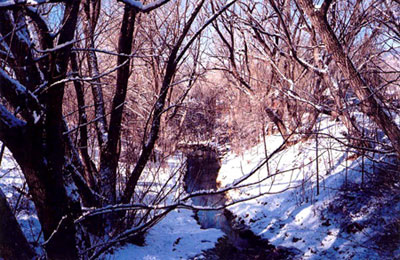
Figure 1. Riparian forest buffer in winter along Middle Shooks Run.
The Shooks Run Agroforestry Project is a voluntary community initiative with the goal of cultivating ecologically sustainable agroforests along Shooks Run. It integrates woody agriculture with the riparian ecosystem, thereby synthesizing human and forest communities.
Riparian Forest Analysis
The initial phase of the project involved a search for and analysis of a deciduous, multistrata, riparian forest typical of the high plains ecosystem of El Paso County. The chosen survey site consisted of a 202-foot diameter circle (32,047 sq. ft.) within a mature, riparian cottonwood forest located on Fountain Creek, to which Shooks Run is a tributary.
Canopy widths and heights were measured and keyed to each woody plant on the site, with the exception of western snowberry (Symphoricarpos occidentalis), since its individual plant canopies were considered too numerous to measure. Stem measurements at breast height were also recorded and keyed to each tree.
Woody plants plotted for analysis on AutoCAD drawings included those of six species distributed over most of the site and those of two additional species that compose significant portions of the site's woody life form biomass. The drawings were converted to ArcView GIS (geographic information system), resulting in a scaled schematic map of the plant canopies and colonies of eight woody species. The GIS was then used to detect "patches" as the basic units of analysis.
Patches are areas of vegetation that display a consistent composition and structure (USDA Forest Service 2005), which differ from the surrounding vegetation. Native patches were initially defined as individual dominant canopy trees and the associate understory shrubs that they overlap.
* Patches that contain all of the mapped native species, with vegetation distributed in several vertical strata or layers, are termed "multistrata".
* Patches that contain fewer native species, with most vegetation in the dominant tree canopy layer, are termed "overstory".
* Patches that contain no dominant tree canopy, with most vegetation in the shrub layer, are termed "understory".
The boxes in Figure 2 depict the three patch types by characteristic vertical stratification of the mapped native and non-native woody species on the site. The circular survey site and legend in Figure 3 further define the patches by their horizontal distribution across the site.
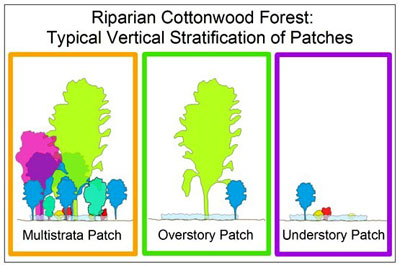
Figure 2. Riparian forest patches differ significantly in composition and structure.
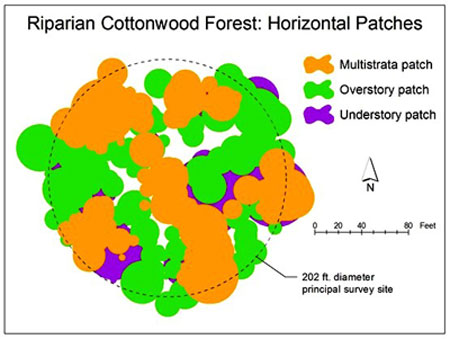
Figure 3. ArcView GIS map composed of woody plant canopies depicting three patch types.
Positive Symbiosis
Positive symbiosis is most apparent with the increased manifestation of guild biomass in multistrata patches. Guilds are groups of species that utilize habitat in a similar manner (Smith and Smith 2001), such as understory trees or shrubs, and can be used as units of analysis (Odum 1983).
Guilds were defined by nativity (native or non-native) and life form (trees or shrubs). Basal area (total trunk cross-sectional area) was the biomass indicator for trees and total canopy area was the biomass indicator for shrubs (see Figure 4). one species, Tatarian honeysuckle (Lonicera tatarica), did not conform to the guild groupings and was analyzed separately.
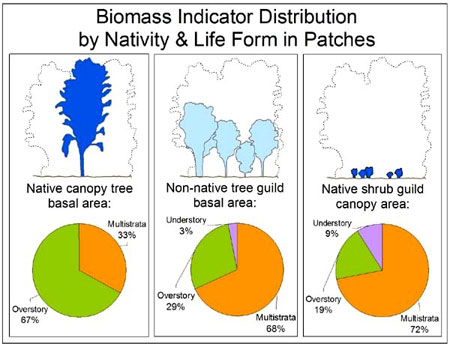
Figure 4. Positive symbiosis clearly benefits the non-native tree guild and native shrub guild in multistrata patches.
Although only 22 percent (15 trees) of the native cottonwood (Populus sargentii) canopy trees are in multistrata patches, they comprise 33 percent of the species' basal area on the survey site. The remaining 53 trees (78 percent) are in overstory patches, comprising 67 percent of the species' basal area on the survey site.
The non-native green ash (Fraxinus pennsylvanica), Siberian elm (Ulmus pumila) and crack willow (Salix fragilis) understory trees have 68 percent of their combined basal area in multistrata patches. These invasive understory trees have occupied an open habitat (Perry 1994) beneath the native canopy trees. However, more than twice as much of their basal area is in the multistrata patches than in the overstory patches. The non-native tree basal area distribution coincides closely with the native shrub canopy area distribution.
Individual canopy measurements were taken of two native shrub species. The golden currant (Ribes aureum) and common chokecherry (Prunus virginiana) shrubs have 72 percent of their combined canopy area in the multistrata patches. Additionally, colonies of native western snowberry (S. occidentalis) are present in all of the multistrata patches. Tatarian honeysuckle (L. tatarica), a non-native shrub, is about equally invasive in all of the patches. Its cross-guild character may somehow allow its relatively uniform access.
Ecological Synergy
Odum's positive symbiosis principle points to the development of ecological synergy that enhances the survival of the non-native tree guild, as well as the native shrub guild, in multistrata patches of the mature forest (Perry 1994). This would help to explain the non-native tree guild's much greater basal area in the multistrata patch type, while the same habitat is clearly available, but much less utilized in the overstory patch type. Laboratory tests of patch type soils at the survey site have indicated no substantial differences in their physical or chemical properties.
If the positive symbiosis explanation is correct, it may be possible to cultivate ecological synergy in the non-multistrata patches. By inserting the appropriate native species, or "keystones" lacking in the composition of those patches, the capacity of the forest to sustain other native or non-native agroforestry species could increase significantly (Perry 1994). Such a practice may have the potential to mutually benefit native biodiversity and woody agriculture in other forest ecosystems as well.
Nevertheless, as positive symbiosis may develop in the cultivated patches, so may susceptibility to invasion, as with the non-native understory tree guild. It may therefore be essential to manage the cultivated patches with additional species that will compete effectively with invasive species.
Agroforestry Field Guide
A model was developed by determining the typical horizontal spacing of common woody plants found in the multistrata patches of the survey site. That model was generalized into a field guide that can be used to direct the dispersal of plants needed to enhance or emulate the multistrata structure of the riparian forest (Figure 5). The large-scale of the field guide facilitates its use within the confines of a riparian forest corridor, community agroforest or homegarden.
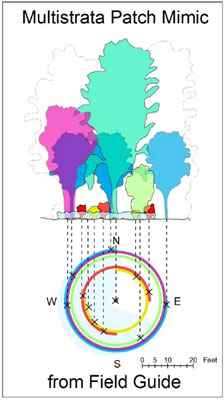
Figure 5. From the center of the dominant canopy tree, a multistrata patch mimic is assembled using a typical concentric spacing of native species and non-native tree life forms.
The field guide is used at the center of each cottonwood tree canopy. From that point, existing understory species are noted and supplemented where needed according to the median concentric locations of species or tree life forms in the guide. Multistrata patch plant densities at the survey site were used to determine the appropriate number of plants of each native species and non-invasive tree life form (substituted for invasive species) in a cottonwood tree's understory.
Sophisticated precursors of Odum's principle and the field guide are noted in ethnoecologist Darrell Posey's depiction of an Amazonian Indian tribe's agricultural practices: "The Kayapo are aware that some species develop more vigorously when planted together. They frequently speak of plants that are 'good friends' or 'good neighbors'". The Kayapo characterize such synergistic plant groups in terms of 'plant energy'. These groups can include dozens of species and require complex patterns of cultivation" (Posey 1991).
Implementation
Initial enhancement efforts are primarily focused on the existing forest buffer along a 1500-foot reach of Shooks Run (Figure 6). The field guide is being used there to direct the dispersal of native plants for positive symbiosis. Planting and establishment irrigation are provided by volunteers on public property and by property owners on private parcels.
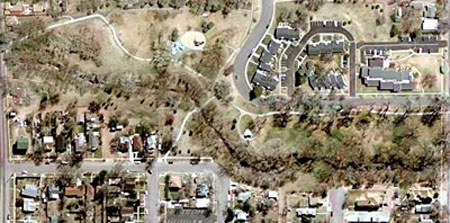
Figure 6. Riparian forest buffer enhancement area along middle Shooks Run in Colorado Springs.
The provision of woody plants needed to initiate the project was accomplished through the development of a native plant nursery. Species currently in production include those referenced in the field guide: plains cottonwood (P. sargentii), common chokecherry (P. virginiana), golden currant (R. aureum) and western snowberry (S. occidentalis). Other tree life forms referenced in the field guide and in production are represented by: boxelder maple (Acer negundo), peachleaf willow (Salix amygdaloides), crabapple (Malus spp.) and American plum (Prunus americana).
Transitional species for upland soils along the outer edge of the riparian forest are also in production. They include native western hackberry (Celtis occidentalis), three-leaf sumac (Rhus trilobata), Woods' rose (Rosa woodsii), western serviceberry (Amelanchier alnifolia) and gooseberry (Ribes inerme), along with non-native bur oak (Quercus macrocarpa) and honeylocust (Gleditsia triacanthos).
The project provides complementary plants from its nursery to help motivate community participation. It also furnishes training in use of the field guide and in native plant propagation and establishment.
Acknowledgements
Assistance from the faculty and staffs of Pikes Peak Community College, Colorado Division of Wildlife and El Paso County Parks is gratefully acknowledged.
Questions and comments are welcome at: shooksrun_agroforestry[at]yahoo.com. All photos and illustrations were provided by the author.
References
Odum, E.P. 1983. Basic Ecology. Saunders College Publishing. 613 p.
Perry, D.A. 1994. Forest Ecosystems. Johns Hopkins University Press. 649 p.
Posey, D. 1991. Forest islands, Kayapo example. Agroforester.net. <http://agroforestry.net/overstory/overstory34.html>.
Smith, R.L. and Smith, T.M. 2001. Ecology and Field Biology, 6th ed. Benjamin Cummings. 771 p.
USDA Forest Service. 2005. People's glossary of ecosystem management terms. <http://www.fs.fed.us/land/emterms.html>.
By Gary Rapp
Shooks Run Agroforestry Project, Colorado Springs, CO



